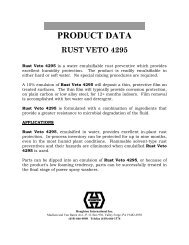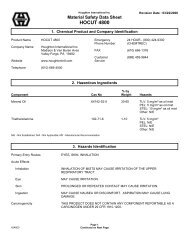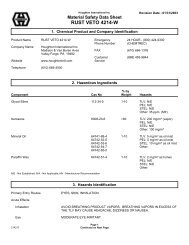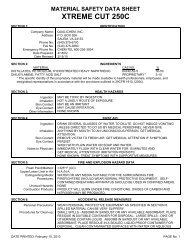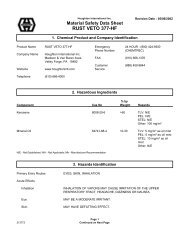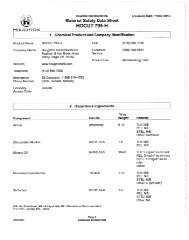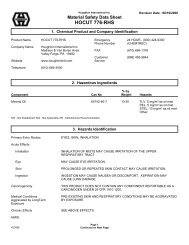Machining of Ceramics - Quality Tools & Services, Inc.
Machining of Ceramics - Quality Tools & Services, Inc.
Machining of Ceramics - Quality Tools & Services, Inc.
You also want an ePaper? Increase the reach of your titles
YUMPU automatically turns print PDFs into web optimized ePapers that Google loves.
Understanding <strong>Ceramics</strong> for Job-Shop Options<br />
_<br />
Page 1<br />
proud partners with<br />
i<br />
Understanding <strong>Ceramics</strong> for Job-Shop Options<br />
02/22/2010<br />
By Mark Vidaic<br />
Many shops struggle to <strong>of</strong>fset the recent declines in revenue that<br />
have resulted from the weakened manufacturing sector,<br />
domestically and globally. While bureaucrats and bankers play<br />
with small-business credit, the average job shop may need to<br />
look inside to find ways to grow or restructure its capabilities,<br />
with minimal investment.<br />
One way to do this is to expand the range <strong>of</strong> materials a shop<br />
can machine effectively. As an engineering material, ceramics<br />
pose different challenges for production methods, compared to a<br />
plastic or metal. Staying ahead <strong>of</strong> the knowledge curve can put a<br />
shop into position to benefit from a growing niche technology<br />
and market.<br />
<strong>Ceramics</strong> are little understood in the high-tech world. Most<br />
application engineers do not think <strong>of</strong> ceramics as a stable<br />
material for manufacturing components. But, ceramics have<br />
found their way into some <strong>of</strong> the toughest applications and<br />
environments in the technical space. From aerospace to wearresistant<br />
pump drives and rotors, to solar applications and even<br />
in the depths <strong>of</strong> the earth as components in down-hole oil and<br />
gas exploration, ceramics are becoming the material <strong>of</strong> choice<br />
A job shop with a standard<br />
capability in CNC machining can<br />
produce precision ceramic parts if it<br />
chooses the materials properly and<br />
approaches the process carefully.<br />
when properties such as high temperature, dimensional stability, chemical/corrosion resistance, and<br />
electrical insulation are required. Many <strong>of</strong> your existing customers may already have a need for<br />
ceramic components, and your relationships may already be a foot in the door to a new opportunity.<br />
The label “ceramics” covers a broad range <strong>of</strong> materials. There are many compositions for different<br />
applications. With cost-containment as a driver, the average shop needs only to learn some <strong>of</strong> the<br />
basics to start machining the “machinable” class <strong>of</strong> ceramic material — like Macor ® , alumina silicate,<br />
boron nitride and other glass mica composites make up the majority <strong>of</strong> this class.<br />
Corning’s Macor ® is a machinable<br />
glass ceramic widely used in<br />
aerospace, medical and semiconductor<br />
applications.<br />
For the low- to medium-volume precision work, Macor ® is a<br />
material that even a modestly equipped shop can machine into<br />
precision ceramic parts. Macor ® is a Corning <strong>Inc</strong>. material.<br />
Corning is well know for its glass products and Macor ® is a hybrid<br />
machinable glass-ceramic that can be fabricated into intricate<br />
shapes with tolerances on the order <strong>of</strong> 0.0002 in., with ordinary<br />
carbide tooling. For Ceramic Products <strong>Inc</strong>. Macor ® and other<br />
types <strong>of</strong> machinable ceramics are a long-term solution, but also<br />
a bridge material for prototypes that eventually may get<br />
fabricated out <strong>of</strong> “tougher” fired ceramics. Macor ® ’s advantage is<br />
that it does not need to be machined in a “green” state and then<br />
fired. Fired ceramics typically need additional machining with<br />
diamond grit-bonded tooling to achieve the tighter tolerances via<br />
grinding instead <strong>of</strong> cutting.
Understanding <strong>Ceramics</strong> for Job-Shop Options<br />
Page 2<br />
Choosing the right tooling is likely to be the most complicated<br />
part <strong>of</strong> the learning process. Talk to your current suppliers, as<br />
they will have some <strong>of</strong> the best insight for you. For most<br />
machinable ceramics, solid carbide tooling is your best bet. Two flute end mills may cut more freely<br />
than 4 and 6 flute. There are some s<strong>of</strong>ter ceramics that are bisque or partially fired and not fully<br />
dense, and although they machine freely, these materials are very abrasive and will wear on the tool’s<br />
edge even faster than the denser machinable glass ceramics, such as Macor ® .<br />
For these materials, use diamond-plated burrs for milling and drilling. These tools will be a little more<br />
costly, but they will last surprisingly long because they will not wear like carbide. All diamond tooling<br />
will require the use <strong>of</strong> coolant to keep the tool free <strong>of</strong> mud/powder, in order to keep it cutting. It’s<br />
always helpful to wet machine ceramics to keep the workpiece and tool cool, regardless <strong>of</strong> whether it’s<br />
a solid-carbide tool or diamond-plated tool. This will extend tool life as well as introduce less stress<br />
into the material.<br />
Keep in mind that with wet or dry machining you are making<br />
either dust or mud, not chips. Some ceramics like boron nitride<br />
must be dry-machined, because they are porous ceramics and<br />
<strong>of</strong>ten used in applications where machining oils would be<br />
detrimental to the end use applications.<br />
The resistance to machining ceramics has a lot to do with a<br />
reluctance to subject machine tools to such an abrasive material.<br />
However, if you were to dedicate a CNC retr<strong>of</strong>it knee mill/bed<br />
mill, or an older machine tool, the benefits will outweigh the<br />
machine wear. Remember, if you are at the point where you are<br />
wearing your machines you should be bringing in enough<br />
business to warrant dedicated equipment and setups.<br />
If you have an old CNC sitting in the corner <strong>of</strong> the shop, it may<br />
be more advantageous to use it for these types <strong>of</strong> R&D projects<br />
than letting some auctioneer take it for next to nothing. Also,<br />
ceramics are not generally made into large components, because<br />
the material generally is not intended for use as the main<br />
component structure. They are usually used in an insulator<br />
application targeting a specific area <strong>of</strong> the end assembly. The<br />
point is that ceramic components are generally small and do not<br />
require large, expensive machines. Because ceramics are difficult<br />
Wet machining or drilling is<br />
preferred for ceramic materials, in<br />
order to keep the workpiece and<br />
tool cool (to extend service life)<br />
and to reduce the level <strong>of</strong> stress on<br />
the material.<br />
Ceramic materials are used in some<br />
<strong>of</strong> the most demanding applications<br />
and environments, from aerospace<br />
to wear-resistant pump drives and<br />
rotors, to solar applications and<br />
even in down-hole oil and gas<br />
exploration. They are valued for<br />
their high-temperature properties,<br />
dimensional stability,<br />
chemical/corrosion resistance, and<br />
electrical insulation.<br />
to machine the average component may be a 2-axis or 3-axis job, at most. But even though they are<br />
not complicated, it’s possible to achieve a higher pr<strong>of</strong>it margin, because there are few shops willing to<br />
expand their portfolio to include ceramic materials.<br />
<strong>Machining</strong> procedures for ceramics will pose an initial challenge,<br />
too, because they are so unfamiliar. <strong>Ceramics</strong> <strong>of</strong> all types are<br />
fragile under tensile forces, but exhibit great strength under<br />
compressive forces. This needs to be taken into account when<br />
deciding how to approach the workpiece. <strong>Ceramics</strong> such as<br />
Macor ® will chip-out when milling if you exit the workpiece. The<br />
tool should remain in the cut as much as possible, and climb<br />
cutting is preferred to reduce chipping.<br />
In many cases you cannot avoid exiting the workpiece, but if you<br />
leave excess material on the OD or pr<strong>of</strong>ile <strong>of</strong> the workpiece you<br />
can clean up any defects as a final step, and make chip free<br />
parts. Sub-plates are a must for any through features, and they<br />
are a good way to incorporate workpiece holding. Because<br />
ceramics aren’t magnetic you can’t use magnetic chucks to hold<br />
the workpiece. Fencing the ceramic on a magnetic chuck with<br />
metal stock or waxing/taping to a sub-plate is a good alternative.<br />
Most <strong>of</strong> the tricks you’ll need to learn about machining ceramics<br />
will be discovered on your own. There are resources available to<br />
you, though, including the companies like Ceramic Products <strong>Inc</strong>. that supply — and have experience<br />
at machining — many <strong>of</strong> the materials discussed here.<br />
Mark Vidaic is the operations manager with Ceramic Products <strong>Inc</strong>., which machines advanced<br />
ceramics and technical plastics. Contact him at markv@ceramicproductsinc.com, or visit<br />
www.ceramicproductsinc.com
Understanding <strong>Ceramics</strong> for Job-Shop Options<br />
_<br />
Page 3<br />
Guide to ceramic materials<br />
Macor ® — This machinable glass ceramic is made exclusively by Corning <strong>Inc</strong>., and has found many<br />
uses in aerospace, medical and semi-conductor applications. Macor ® machinable glass ceramic can<br />
reduce costs where lower-volume quantities are needed and high-priced tooling charges are not an<br />
option.<br />
Macor ® has a continuous-use temperature <strong>of</strong> 800°C and a peak temperature <strong>of</strong> 1,000°C. It’s<br />
coefficient <strong>of</strong> thermal expansion matches most metals and sealing glasses. Macor ® is non-wetting,<br />
exhibits zero porosity, and unlike ductile materials, won’t deform. It’s an excellent insulator at high<br />
voltages, various frequencies and high temperatures, and won’t “outgas” in vacuum environments.<br />
Alumina — Alumina has good mechanical and electrical properties leading to a wide range <strong>of</strong><br />
applications. Alumina can be produced in a range <strong>of</strong> purities with additives designed to enhance<br />
properties. It can be formed using a wide variety <strong>of</strong> ceramic processing methods and can be<br />
machined or formed to produce a wide variety <strong>of</strong> sizes and shapes. In addition, it can be readily<br />
joined to metals or other ceramics using metalizing and brazing techniques.<br />
Aluminum nitride — Aluminum nitride exhibits lower thermal expansion than alumina that closely<br />
matches the expansion <strong>of</strong> silicon wafers and it can be metalized, making it an ideal material for semi<br />
-conductor applications.<br />
Alumina silicate (Lava) — Alumina silicate or Lava is a machinable ceramic material. It has a high<br />
use temperature, and excellent thermal / electrical insulating properties.<br />
Boron nitride — Boron nitride can be machined using standard carbide drills. BN exhibits a high<br />
electrical resistance, low dielectric constant and loss tangent, low thermal expansion, chemical<br />
inertness and good thermal shock resistance. With these properties BN lends itself a useful material<br />
for vacuum components, various electrical components and nuclear applications.<br />
Glass (Pyrex ® , Vycor ® and similar materials) — Various glasses are used in many applications<br />
where optical high thermal shock resistance and insulating properties are required.<br />
Graphite — Graphite has excellent thermal shock and chemical resistance making it an ideal<br />
material for molds, furnace boats, plating anodes and brazing fixtures.<br />
Mullite — Mullite is an excellent structural material due to its high temperature stability, strength<br />
and creep resistance. It has a low dielectric constant and high electrical insulation capabilities.<br />
Typical applications include Kiln Furniture, furnace center tube, heat exchange parts, heat insulation<br />
parts and rollers.<br />
Mycalex ® — With several grades to choose from, varying in strength and temperature performance,<br />
Mycalex ® is an excellent machinable ceramic insulator material that can be fabricated into complex<br />
parts.<br />
Quartz — With its superior thermal, chemical and optical properties, quartz <strong>of</strong>ten is used in the<br />
lighting and semi-conductor fields.<br />
Silicon carbide — Silicon carbide is known for its high hardness and abrasion resistance. Common<br />
applications include: pump seals, valve components and wear-intensive parts.<br />
Steatite — The cost <strong>of</strong> Steatite is relatively low when compared with other ceramic materials. It’s<br />
useful in applications where insulating and temperature resistance are a concern.<br />
Zirconia — Stabilized zirconia <strong>of</strong>fers chemical and corrosion resistance to temperatures well above<br />
the melting point <strong>of</strong> alumina. Zirconia ceramics have the ability to absorb great amounts <strong>of</strong> stress<br />
relative to other ceramic materials. It exhibits the highest mechanical strength and toughness at<br />
room temperature.<br />
Source: Ceramic Products <strong>Inc</strong>.





